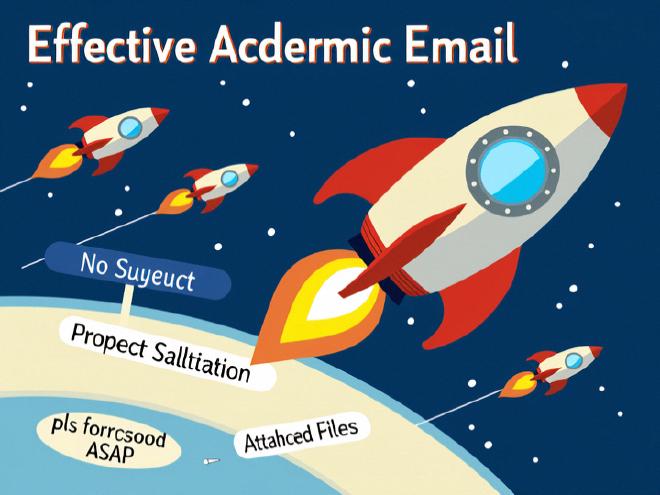避免学术邮件常见错误:教师与研究员必读
Table of Contents
在教育科研领域,电子邮件是日常沟通的核心工具。无论是与同事协作、指导学生,还是向期刊投稿、申请项目资助,一封得体、清晰的邮件往往能决定沟通的成败。然而,许多教师和研究员尽管学术造诣深厚,却常因忽视学术邮件礼仪而造成误解、延误甚至关系紧张。
本文将深入解析科研场景中常见的学术邮件错误,剖析背后的沟通误区,并提供实用的改进策略,帮助您提升专业形象,实现高效、精准的科研沟通。
一、常见的学术邮件错误类型 #

1. 语气不当:过于随意或过于生硬 #
-
问题表现:
- 对导师或评审专家使用“Hey”、“Hi there”等非正式称呼。
- 使用缩写如“u”代替“you”,或表情符号(😊)出现在正式请求中。
- 反之,语气过于冷峻、命令式,如“请立即回复”、“务必今天提交”。
-
后果: 轻则显得不专业,重则被视为缺乏尊重,影响合作意愿。
-
改进方案:
- 使用标准称呼:“尊敬的[姓名]教授”或“Dear Dr. [Last Name]”。
- 保持礼貌且简洁:“希望您一切顺利”、“感谢您的时间与指导”。
- 结尾使用规范落款:“此致 敬礼”或“Best regards”。
✅ 正确示例: 尊敬的李教授: 您好!我是XX大学博士生张伟,目前正在撰写关于气候变化对农业影响的研究论文。冒昧来信,是想请教您2020年发表于《Nature Climate Change》中模型参数的选择依据……
2. 主题行模糊不清或缺失 #
-
问题表现:
- 主题为“您好”、“咨询”、“紧急事项”等泛泛之词。
- 完全空白的主题行。
-
后果: 邮件易被忽略、误判为垃圾邮件,或无法归类存档。
-
改进方案:
- 主题应包含核心信息:目的 + 关键词 + 相关编号(如有)。
- 遵循“谁 + 什么事”的结构。
✅ 推荐格式: 【论文修改咨询】关于投稿《地理学报》的审稿意见回复(稿件编号:GEO-2024-118) 【会议安排】2025年环境科学研讨会筹备组第二次会议通知
3. 遗漏关键附件 #
-
问题表现:
- 正文中提到“详见附件”,但未实际添加文件。
- 附件命名混乱,如“新建 Microsoft Word 文档.docx”。
-
后果: 导致对方反复追问,浪费双方时间,严重时错过截止日期。
-
改进方案:
- 发送前使用清单检查:✅ 内容完整?✅ 附件已附?✅ 命名清晰?
- 附件命名规范:
[姓名]_[用途]_[日期].pdf,例如:王芳_博士开题报告_20250405.pdf
💡 小技巧:可在正文中明确标注:“附件1:研究计划书(王芳_ResearchProposal_2025.pdf)”
4. 信息冗长或结构混乱 #
-
问题表现:
- 一段文字超过10行,无分段。
- 多个问题混杂在一个段落中,难以逐一回应。
-
后果: 收件人阅读困难,容易遗漏重点,降低回复效率。
-
改进方案:
- 使用分点叙述,每段聚焦一个主题。
- 复杂请求可采用编号列表。
✅ 示例结构:感谢您同意担任我博士论文的评审专家。现将相关材料呈上:
- 论文全文(见附件)
- 答辩时间建议:2025年6月10日上午9:00
- 需请您确认的事项:
- 是否有时间出席?
- 是否需要提前收到纸质版?
5. 忽略文化差异与层级关系 #
-
问题表现:
- 向国外学者直接提出高要求,如“请为我写推荐信”而无铺垫。
- 对资深教授直呼其名,未使用职称。
-
后果: 在强调等级与礼节的学术文化中,可能被视为失礼。
-
改进方案:
- 国际通信中更宜保守:始终使用“Dr.”或“Prof.”。
- 提出请求前先表达对其工作的欣赏,建立情感连接。
✅ 正确表达: I have long admired your work on renewable energy policy, particularly your 2023 paper in Energy Policy. I am currently applying for the Fulbright Scholarship and would be deeply honored if you could consider writing a recommendation letter.
二、科研沟通中的深层误区 #
除了表面错误,一些科研沟通误区也值得警惕:
❌ 误区一:认为“内容重要即可,形式无关紧要” #
- 现实:第一印象由格式与语言质量决定。错别字、语法错误会削弱学术可信度。
❌ 误区二:群发邮件不加区分 #
- 风险:将不同身份的人(如学生、院长、外部合作者)混在同一封邮件中,可能导致信息泄露或尴尬。
- 建议:使用“BCC”保护隐私,或分别发送定制化邮件。
❌ 误区三:期待即时回复 #
- 现实:学者日程繁忙,平均响应时间为2–3个工作日。
- 应对:若紧急,可在主题中标明【紧急】并说明原因,但仍需保持礼貌。
三、构建高效学术邮件的五大原则 #

为了帮助您系统性规避学术邮件错误,我们总结了以下五项黄金原则:
| 原则 | 具体做法 |
|---|---|
| 1. 明确目标 | 每封邮件只解决一个问题,避免多重诉求 |
| 2. 结构清晰 | 采用“背景—请求—附件—致谢”四段式结构 |
| 3. 用语专业 | 避免口语化表达,使用正式书面语 |
| 4. 细节严谨 | 检查拼写、标点、附件、称呼准确性 |
| 5. 换位思考 | 设想对方时间有限,力求简洁高效 |
四、模板参考:三种高频场景 #
📩 场景一:向导师请求反馈 #
主题:【论文初稿提交】关于《城市空气污染建模》的初稿(王磊_20250405)
尊敬的陈老师:
您好!
我在您的指导下完成了题为《基于机器学习的城市空气污染预测模型研究》的论文初稿,现随信附上,恳请您拨冗审阅。
如有任何修改建议,我将认真调整。若您方便,也希望能预约一次15分钟的线上讨论时间。
附件:王磊_论文初稿_20250405.pdf
感谢您一直以来的悉心指导!
此致
敬礼!
王磊
XX大学环境科学与工程学院
邮箱:wanglei@xxu.edu.cn
2025年4月5日
📩 场景二:联系外部合作者 #
主题:【合作邀请】关于联合申报国家自然科学基金的初步探讨
Dear Prof. Smith,
I hope this message finds you well. My name is Dr. Liu Yang from Tsinghua University, and I have been following your recent work on carbon capture materials with great interest.
Given our shared research focus, I would like to explore the possibility of collaborating on a joint proposal for the upcoming NSFC International Cooperation Program. I believe our complementary expertise could lead to impactful outcomes.
Please find a brief project outline attached. Would you be available for a short call next week?
Best regards,
Yang Liu, Ph.D.
Associate Professor, Department of Chemical Engineering
Tsinghua University
Email: liuyang@tsinghua.edu.cn
📩 场景三:回复审稿意见 #
主题:【审稿回复】对《材料科学进展》稿件MS-2025-789的逐条回应
尊敬的编辑部老师:
您好!
感谢您及审稿专家对我投稿论文《纳米复合材料界面增强机制》的细致评审。我们已根据意见逐条修改,具体回应如下:
1. 关于实验样本数量不足的问题(意见#1):我们补充了3组重复实验,数据已更新至图3。
2. 文献引用建议(意见#2):已增加Zhang et al. (2023) 和 Lee (2022) 的相关研究……
修改稿与标注版本已附于本邮件。
再次感谢您的宝贵意见!
此致
敬礼!
赵婷
复旦大学材料科学系
2025年4月5日
结语:细节成就专业 #
在学术界,一封邮件就是一张无形的名片。它不仅传递信息,更折射出您的职业素养与沟通智慧。避免学术邮件错误并非追求完美主义,而是对他人时间的尊重,对自己专业的负责。
从今天起,花三分钟检查主题行、称呼与附件;用五分钟梳理逻辑结构;以同理心打磨每一句话——这些微小改变,将在长期积累中显著提升您的科研沟通效率与学术影响力。
行动建议:收藏本文,或将本文分享给课题组成员,共同建立团队邮件规范。
标签:#学术规范 #沟通技巧 #科研写作 #职场礼仪
